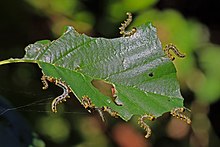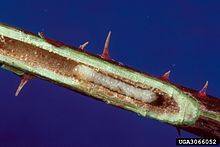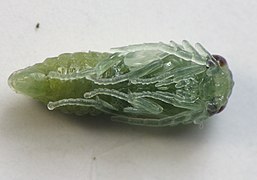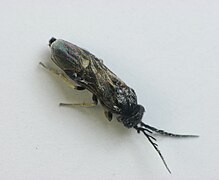Sawfly
| Sawfly Temporal range:
| |
|---|---|

| |
| Tenthredo mesomela | |
| Scientific classification | |
| Domain: | Eukaryota |
| Kingdom: | Animalia |
| Phylum: | Arthropoda |
| Class: | Insecta |
| Order: | Hymenoptera |
| Suborder: | Symphyta Gerstaecker, 1867[1] |
| Superfamilies[2] | |
| |

Sawflies are
The primary distinction between sawflies and the Apocrita – the ants, bees, and wasps – is that the adults lack a "wasp waist", and instead have a broad connection between the
Predators include birds, insects and small animals. The larvae of some species have
Adult sawflies are short-lived, with a life expectancy of 7–9 days, though the larval stage can last from months to years, depending on the species. Parthenogenetic females, which do not need to mate to produce fertilised eggs, are common in the suborder, though many species have males. The adults feed on pollen, nectar, honeydew, sap, other insects, including hemolymph of the larvae hosts; they have mouth pieces adapted to these types of feeding.[3]
Sawflies go through a
Sawflies first appeared 250 million years ago in the
Etymology

The suborder name "Symphyta" derives from the Greek word symphyton, meaning "grown together", referring to the group's distinctive lack of a wasp waist between prostomium and peristomium.[4] Its common name, "sawfly", derives from the saw-like ovipositor that is used for egg-laying, in which a female makes a slit in either a stem or plant leaf to deposit the eggs.[5] The first known use of this name was in 1773.[6] Sawflies are also known as "wood-wasps".[7]
Phylogeny

In his original description of
The Symphyta have therefore traditionally been considered, alongside the Apocrita, to form one of two
While most hymenopteran superfamilies are
The oldest unambiguous sawfly fossils date back to the Middle or Late Triassic. These fossils, from the family Xyelidae, are the oldest of all Hymenoptera.[16] One fossil, Archexyela ipswichensis from Queensland is between 205.6 and 221.5 million years of age, making it among the oldest of all sawfly fossils.[17] More Xyelid fossils have been discovered from the Middle Jurassic and the Cretaceous, but the family was less diverse then than during the Mesozoic and Tertiary. The subfamily Xyelinae were plentiful during these time periods, in which Tertiary faunas were dominated by the tribe Xyelini; these are indicative of a humid and warm climate.[18][19][20]
The cladogram is based on Schulmeister 2003.[21][22]
| Symphyta within Hymenoptera | |||||||||||||||||||||||
| |||||||||||||||||||||||
| Symphyta (red bar) are paraphyletic as Apocrita are excluded. |
Taxonomy
There are approximately 8,000 species of sawfly in more than 800 genera, although new species continue to be discovered.
Extinct taxa are indicated by a
- Superfamilies and families
- Superfamily AnaxyeloideaMartynov, 1925
- Family Anaxyelidae Martynov, 1925 (1 species) & †12 genera
- Superfamily Cephoidea Newman, 1834 (1 & †1family)
- Superfamily †KaratavitoideaRasnitsyn, 1963 (1 family)
- Family †Karatavitidae Rasnitsyn, 1963 (7 genera)
- Superfamily Orussoidea Newman, 1834 (1 & †1 family)
- Family Orussidae Newman, 1834 (16 genera, 82 spp.) & †3 genera
- Superfamily syn.Megalodontoidea)
- Family Megalodontesidae Konow, 1897 (1 genera, 42 spp.) & †1 genus
- Family Pamphiliidae Cameron, 1890 (10 genera, 291 spp.) & †3 genera
- Superfamily Siricoidea Billberg, 1820 (2 & †5 families)
- Family SiricidaeBillberg, 1820 (11 genera, 111 spp.) & †9 genera
- Family
- Superfamily Tenthredinoidea Latreille, 1803 (6 & †2 families)
- Family Argidae Konow, 1890 (58 genera, 897 spp.) and †1 genus
- Family Blasticotomidae Thomson, 1871 (2 genera, 12 spp.) & †1 genus
- Family Cimbicidae W. Kirby, 1837 (16 genera, 182 spp.) & †6 genera
- Family Diprionidae Rohwer, 1910 (11 genera, 136 spp.) & †2 genera
- Family Pergidae Rohwer, 1911 (60 genera, 442 spp.)
- Family Tenthredinidae Latreille, 1803 (400 genera, 5,500 spp.) & †14 genera
- Superfamily XiphydrioideaLeach, 1819
- Family Xiphydriidae Leach, 1819 (28 genera, 146 spp.)
- Superfamily XyeloideaNewman, 1834
- Family Xyelidae Newman, 1834 (5 genera, 63 spp.) & †47genera
Description
It does not sting.
Many species of sawfly have retained their ancestral attributes throughout time, specifically their plant-eating habits, wing veins and the unmodified abdomen, where the first two segments appear like the succeeding segments.[30] The absence of the narrow wasp waist distinguishes sawflies from other members of hymenoptera, although some are Batesian mimics with coloration similar to wasps and bees, and the ovipositor can be mistaken for a stinger.[31] Most sawflies are stubby and soft-bodied, and fly weakly.[32] Sawflies vary in length: Urocerus gigas, which can be mistaken as a wasp due to its black-and-yellow striped body, can grow up to 20 mm (3⁄4 in) in length, but among the largest sawflies ever discovered was Hoplitolyda duolunica from the Mesozoic, with a body length of 55 mm (2+1⁄4 in) and a wingspan of 92 mm (3+1⁄2 in).[31][33] The smaller species only reach lengths of 2.5 mm (3⁄32 in).[34]
Heads of sawflies vary in size, shape and sturdiness, as well as the positions of the eyes and antennae. They are characterised in four head types: open head, maxapontal head, closed head and genapontal head. The open head is simplistic, whereas all the other heads are derived.[35] The head is also hypognathous, meaning that the lower mouthparts are directed downwards. When in use, the mouthparts may be directed forwards, but this is only caused when the sawfly swings its entire head forward in a pendulum motion.[36] Unlike most primitive insects, the sutures (rigid joints between two or more hard elements on an organism) and sclerites (hardened body parts) are obsolescent or absent. The clypeus (a sclerite that makes up an insects "face") is not divided into a pre- and postclypeus, but rather separated from the front.[37] The antennal sclerites are fused with the surrounding head capsule, but these are sometimes separated by a suture. The number of segments in the antennae vary from six in the Accorduleceridae to 30 or more in the Pamphiliidae.[38] The compound eyes are large with a number of facets, and there are three ocelli between the dorsal portions of the compound eyes.[37] The tentorium comprises the whole inner skeleton of the head.[39]
Three segments make up the thorax: the mesothorax, metathorax and prothorax, as well as the exoskeletal plates that connect with these segments.[40] The legs have spurs on their fourth segments, the tibiae.[41] Sawflies have two pairs of translucent wings. The fore and hind wings are locked together with hooks.[42] Parallel development in sawfly wings is most frequent in the anal veins. In all sawflies, 2A & 3A tend to fuse with the first anal vein. This occurs in several families including Argidae, Diprionidae and Cimbicidae.[43]
The larvae of sawflies are easily mistaken for
Distribution
Sawflies are widely distributed throughout the world.
Behaviour and ecology

Sawflies are mostly

Sawflies are eaten by a wide variety of predators. While many birds find the larvae distasteful, some such as the
The larvae have several
Parasites

Sawflies are hosts to many parasitoids, most of which are parasitic Hymenoptera; more than 40 species are known to attack them. However, information regarding these species is minimal, and fewer than 10 of these species actually cause a significant impact on sawfly populations.[60] Many of these species attack their hosts in the grass or in other parasitoids.[clarification needed] Well known and important parasitoids include Braconidae, Eulophidae and Ichneumonidae. Braconid wasps attack sawflies in many regions throughout the world, in which they are ectoparasitoids, meaning that the larvae live and feed outside of the hosts body; braconids have more of an impact on sawfly populations in the New World than they do in the Old World, possibly because there are no ichneumonid parasitoids in North America. Some braconid wasps that attack sawflies include Bracon cephi, B. lisogaster, B. terabeila and Heteropilus cephi.[60][61][62] Female braconids locate sawfly larvae through the vibrations they produce when feeding, followed by inserting the ovipostior and paralysing the larva before laying eggs inside the host. These eggs hatch inside the larva within a few days, where they feed on the host. The entire host's body may be consumed by the braconid larvae, except for the head capsule and epidermis. The larvae complete their development within two or three weeks.[60]
Ten species of wasps in the family Ichneumonidae attack sawfly populations, although these species are usually rare. The most important parasitoids in this family are species in the genus Collyria. Unlike braconids, the larvae are endoparasitoids, meaning that the larvae live and feed inside the hosts body.[60] One well known ichneumonid is Collyria coxator, which is a dominant parasitoid of C. pygmaeus. Recorded parasitism rates in Europe are between 20 – 76%, and as many as eight eggs can be found in a single larva, but only one Collyria individual will emerge from its host. The larva may remain inside of their host until spring, where it emerges and pupates.[60]
Several species in the family Eulophidae attack sawflies, although their impact is low. Two species in the genus Pediobius have been studied; the two species are internal larval parasitoids and have only been found in the northern hemisphere. Parasitism of sawflies by eulophids in grass exceeds 50%, but only 5% in wheat. It is unknown as to why the attack rate in wheat is low.[63] Furthermore, some fungal and bacterial diseases are known to infect eggs and pupa in warm wet weather.[50]
Outbreaks of certain sawfly species, such as Diprion polytomum, have led scientists to investigate and possibly collect their natural enemies to control them. Parasites of D. polytomum have been extensively investigated, showing that 31 species of hymenopterous and dipterous parasites attack it. These parasites have been used in successful biological control against pest sawflies, including Cephus cinctus throughout the 1930s and 1950s and C. pygmaeus in the 1930s and 1940s.[64][65]
Life cycle and reproduction

Like all other hymenopteran insects, sawflies go through a complete metamorphosis with four distinct life stages – egg, larva, pupa and adult.[66] Many species are parthenogenetic, meaning that females do not need fertilization to create viable eggs. Unfertilized eggs develop as male, while fertilized eggs develop into females (arrhenotoky). The lifespan of an individual sawfly is two months to two years, though the adult life stage is often very short (approximately 7 – 9 days), only long enough for the females to lay their eggs.[31][50][67] The female uses its ovipositor to drill into plant material to lay her eggs (though the family Orussoidea lay their eggs in other insects). Plant-eating sawflies most commonly are associated with leafy material but some specialize on wood, and the ovipositors of these species (such as the family Siricidae) are specially adapted for the task of drilling through bark. Once the incision has been made, the female will lay as many as 30 to 90 eggs. Females avoid the shade when laying their eggs because the larvae develop much slower and may not even survive, and they may not also survive if they are laid on immature and glaucous leaves. Hence, female sawflies search for young adult leaves to lay their eggs on.[31][50]
These eggs hatch in two to eight weeks, but such duration varies by species and also by temperature. Until the eggs have hatched, some species such as the small brown sawfly will remain with them and protects the eggs by buzzing loudly and beating her wings to deter predators. There are six larval stages that sawflies go through, lasting 2 – 4 months, but this also depends on the species. When fully grown, the larvae emerge from the trees en masse and burrow themselves into the soil to pupate. During their time outside, the larvae may link up to form a large colony if many other individuals are present. They gather in large groups during the day which gives them protection from potential enemies, and during the night they disperse to feed. The emergence of adults takes awhile, with some emerging anywhere between a couple months to 2 years. Some will reach the ground to form pupal chambers, but others may spin a cocoon attached to a leaf. Larvae that feed on wood will pupate in the tunnels they have constructed. In one species, the jumping-disc sawfly (Phyllotoma aceris) forms a cocoon which can act like a parachute. The larvae live in sycamore trees and do not damage the upper or lower cuticles of leaves that they feed on. When fully developed, they cut small perforations in the upper cuticle to form a circle. After this, they weave a silk hammocks within the circle; this silk hammock never touches the lower cuticle. Once inside, the upper-cuticle's disc separates and descends towards the surface with the larvae attaching themselves to the hammock. Once they reach the round, the larvae work their way into a sheltered area by jerking their discs along.[31][50]
The majority of sawfly species produce a single generation per year, but others may only have one generation every two years. Most sawflies are also female, making males rare.[50]
- Life cycle of the sawfly Cladius difformis, the bristly rose slug
-
Larva
-
Pupa, dorsal view
-
Pupa, ventral view
-
Female
-
Male
Relationship with humans

Sawflies are major economic pests of
Sawflies are serious pests in horticulture. Different species prefer different host plants, often being specific to a family or genus of hosts. For example, Iris sawfly larvae, emerging in summer, can quickly defoliate species of Iris including the yellow flag and other freshwater species.[69] Similarly the rose sawflies, Arge pagana and A. ochropus, defoliate rose bushes.[70]
The giant woodwasp or horntail, Urocerus gigas, has a long ovipositor, which with its black and yellow colouration make it a good mimic of a hornet. Despite the alarming appearance, the insect cannot sting.[71] The eggs are laid in the wood of conifers such as Douglas fir, pine, spruce, and larch. The larvae eat tunnels in the wood, causing economic damage.[72]
Alternative measures to control sawflies can be taken. Mechanical methods include removing larvae from trees and killing them by squishing or dropping them into boiling water or kerosene, although this is not practical in plantations. Predators can also be used to eliminate larvae, as well as parasites which have been previously used in control programs.[50][64] Small trees can be sprayed with a number of chemicals, including maldison, dimethoate and carbaryl, if removing larvae from trees is not effective enough.[50]
References
- ^ a b Gerstaecker, C.E.A. (1867). "Ueber die Gattung Oxybelus Latr. und die bei Berlin vorkommenden Arten derselben". Zeitschrift für die Gesammten Naturwissenschaften (in German). 30 (7): 1–144.
- ^ PMID 26146682.
- .
- ^ "Symphyta". Merriam-Webster. Retrieved 2 December 2016.
- ^ a b c Australian Museum (20 October 2009). "Animal Species: Sawflies". Retrieved 11 August 2015.
- ^ "Sawfly". Merriam-Webster Online Dictionary. Retrieved 29 November 2016.
- ISBN 978-1-84593-542-9.
- OCLC 2962429.
- OCLC 6344527.
- ^ a b Goulet & Huber 1993, p. 5.
- ^ .
- ^ PMID 25542648.
- S2CID 33628659.
- ^ PMID 26879745.
- OCLC 1612960.
- ISBN 978-0-323-14979-2.
- ^ Engel, M.S. (2005). "A new sawfly from the Triassic of Queensland (Hymenoptera: Xyelidae)". Memoirs of the Queensland Museum. 51 (2): 558.
- S2CID 129371522.
- S2CID 87932664.
- S2CID 15668901.
- .
- ^ Schulmeister, S. "Symphyta". Archived from the original on 21 June 2010. Retrieved 28 November 2016.
- ^ a b Capinera 2008, pp. 3250–3252.
- ISSN 1175-5334.
- PMID 27222635.
- ^ Taeger, A.; Blank, S.M. (1996). "Kommentare zur Taxonomie der Symphyta (Hymenoptera): Vorarbeiten zu einem Katalog der Pflanzenwespen, Teil 1". Beiträge zur Entomologie (in German). 46 (2): 251–275.
- .
- PMID 7937916.
- ^ Goulet & Huber 1993, p. 104.
- ^ Goulet & Huber 1993, pp. 5–6.
- ^ ISBN 978-0-7614-7282-7.
- ^ a b Goulet & Huber 1993, p. 6.
- PMID 23671596.
- OCLC 429798429. Archived from the original(PDF) on 24 September 2015.
- ^ Ross 1937, p. 11.
- ^ Ross 1937, p. 9.
- ^ a b Ross 1937, p. 10.
- ^ Ross 1937, p. 21.
- ^ Ross 1937, p. 13.
- ^ Ross 1937, pp. 22–29.
- ^ Ross 1937, p. 27.
- ISBN 978-1-317-93777-7.
- ^ Ross 1937, p. 29.
- .
- ISBN 978-0-323-13940-3.
- ^ a b "Sawflies (Tenthredinoidae)". BBC. 2014. Retrieved 11 August 2015.
- S2CID 25877174.
- ^ JSTOR 1369468.
- S2CID 86569805.
- ^ a b c d e f g h i j k Phillips, C. (1992). "Spitfires – Defoliating Sawflies" (PDF). Department of Primary Industries and Resources. Government of South Australia. Archived from the original (PDF) on 6 April 2015. Retrieved 11 August 2015.
- ISSN 0963-8091.
- .
- .
- ^ Cayford, J.T. (1990). "Distribution and habitat preferences of Black Grouse in commercial forests in Wales: conservation and management implications". Proceedings of the International Union Game of Biologists Congress. 19: 435–447.
- S2CID 53474917.
- S2CID 23689052.
- PMID 17540402.
- ^ Phillips, Charlma (December 1992). "Spitfires - Defoliating Sawflies". PIRSA. Archived from the original on 6 November 2009. Retrieved 2010-04-10.
- ISBN 978-0-521-34692-4.
- ^ a b c d e Capinera 2008, p. 1827.
- ^ Alberta Agriculture (1988). Guide to Crop Protection in Alberta. Vol. 2. Alberta: University of Alberta. p. 73.
- S2CID 85132364.
- ^ Capinera 2008, p. 1827–1828.
- ^ a b Capinera 2008, p. 1828.
- .
- ISBN 978-0-19-802817-8.
- .
- ^ Krokene, Paal (6 December 2014). "The common pine sawfly – a troublesome relative". Science Nordic. Archived from the original on 29 November 2016. Retrieved 28 November 2016.
- ^ "Iris sawfly". Royal Horticultural Society. Retrieved 28 November 2016.
- ^ "Large rose sawfly". Royal Horticultural Society. Retrieved 28 November 2016.
- ^ "Great Wood Wasps". UK Safari. Retrieved 28 November 2016.
- ^ "Giant Woodwasp". Massachusetts Introduced Pests Outreach Project. Retrieved 28 November 2016.
Bibliography
- Capinera, J.L. (2008). Encyclopedia of Entomology (2nd ed.). Dordrecht, Netherlands: Springer Science & Business Media. ISBN 978-1-4020-6242-1.
- Goulet, H.; Huber, J.T. (1993). Hymenoptera of the World: An Identification guide to families (PDF). Ottawa, Ontario: Agriculture Canada. ISBN 978-0-660-14933-2. Archived from the original(PDF) on 5 March 2016.
- Ross, H.H. (1937). A Generic Classification of the Nearctic Sawflies (Hymenoptera, Symphyta). Urbana, Illinois: University of Illinois. hdl:2142/27324.
Further reading
- Blank, S.M.; Schmidt, S.; Taeger, A. (2006). Recent Sawfly Research Synthesis and Prospects. Keltern, Germany: Goecke und Evers. ISBN 978-3-937783-19-2.
- Schedl, Wolfgang. (2016). Hymenoptera, Unterordnung Symphyta: Pflanzenwespen. Walter de Gruyter. ISBN 978-3-11-085790-0.
- Smith, D.R. (1969). Nearctic Sawflies I. Blennocampinae: Adults and Larvae (Hymenoptera: Tenthredinidae) (Technical Bulletin 1397). Washington, D.C.: US Department of Agriculture.
- Smith, D.R. (1969). Nearctic Sawflies II. Selandriinae: Adults and Larvae (Hymenoptera: Tenthredinidae) (Technical Bulletin 1398). Washington, D.C.: US Department of Agriculture.
- Smith, D.R. (1971). Nearctic Sawflies III. Heterarthrinae: Adults and Larvae (Hymenoptera: Tenthredinidae). Washington, D.C.: US Department of Agriculture. Archived from the original (Technical Bulletin 1420) on 21 October 2020. Retrieved 29 December 2018.
- Smith, D.R. (1979). Nearctic Sawflies IV. Allantinae: Adults and Larvae (Hymenoptera: Tenthredinidae) (Technical Bulletin 1595). Washington, D.C.: US Department of Agriculture.
- Wagner, M.R.; Raffa, K.F. (1993). Sawfly Life History Adaptations to Woody Plants. San Diego, California: Academic Press. ISBN 978-0-12-730030-6.
External links
General
- Symphyta: Encyclopædia Britannica
- Sawflies: a close relative of wasps at CSIRO
- Symphyta" - Sawflies, Horntails, and Wood Wasps at BugGuide
Taxonomy
- Taxonomy of Hymenoptera – Chrysis.net
- ECatSym - Electronic World Catalog of Symphyta (Insecta, Hymenoptera) – Digital Entomological Information
- Checklist of British and Irish Hymenoptera - Sawflies, ‘Symphyta’ Biodiversity Data Journal 2: e1168














